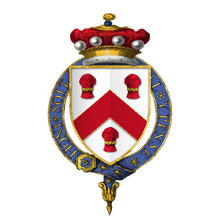The Sheffield Baronetcy, of Normanby in the County of Lincoln, is a title in the Baronetage of Great Britain. It was created on 1 March 1755 for Charles Herbert Sheffield, the illegitimate son of John Sheffield, 1st Duke of Buckingham and Normanby. On the death of his half brother, the 2nd Duke, in 1735, he inherited the family estates including Buckingham House which was sold to George III in 1762 and Normanby Hall which latter remained the family residence until 1963. Thereafter the family's home was Sutton Park, York.
The fourth Baronet served as High Sheriff of Lincolnshire in 1817 and the fifth Baronet in 1872. The sixth Baronet sat as Conservative Member of Parliament for Brigg.
Samantha Cameron is the daughter of the eighth Baronet and Cara Delevingne, the great-great-granddaughter of the sixth Baronet.
Sheffield baronets, of Normanby (1755)
- Sir Charles Herbert Sheffield, 1st Baronet (c. 1706–1774), who was born Charles Herbert and who took the name Sheffield in 1735 on the death of his half-brother Edmund Sheffield.[1]
- Sir John Sheffield, 2nd Baronet (c. 1743–1815)[1]
- Sir Robert Sheffield, 3rd Baronet (c. 1758–1815)[1]
- Sir Robert Sheffield, 4th Baronet (1786–1862)[2]
- Sir Robert Sheffield, 5th Baronet (1823–1886)[2]
- Sir Berkeley Digby George Sheffield, 6th Baronet (1876 Grosvenor Street, London[2]–1946)
- Sir Robert Arthur Sheffield, 7th Baronet (1905–1977)
- Sir Reginald Adrian Berkeley Sheffield, 8th Baronet (born 1946 Marylebone, London)
The heir apparent is Robert Charles Berkeley Sheffield (born 1984 in Scunthorpe)
Coat of arms
- First five baronets bore argent, a chevron between three garbs gules, all within a bordure gobony argent and azure.
- Since 6th baronet they bore argent, a chevron engrailed between two garbs in chief gules, and in base a sheaf of arrows proper, banded also gules.
See also
- Duke of Buckingham and Normanby
- Robert Sheffield,
Notes
- ^ a b c Cokayne 1906, p. 102.
- ^ a b c Cokayne 1906, p. 103.
References
- Cokayne, George Edward, ed. (1906), Complete Baronetage 1707–1800, 5, Exeter: William Pollard and Co, p. 102–103
Further reading
- Burke's Peerage
- Leigh Rayment's list of baronets
